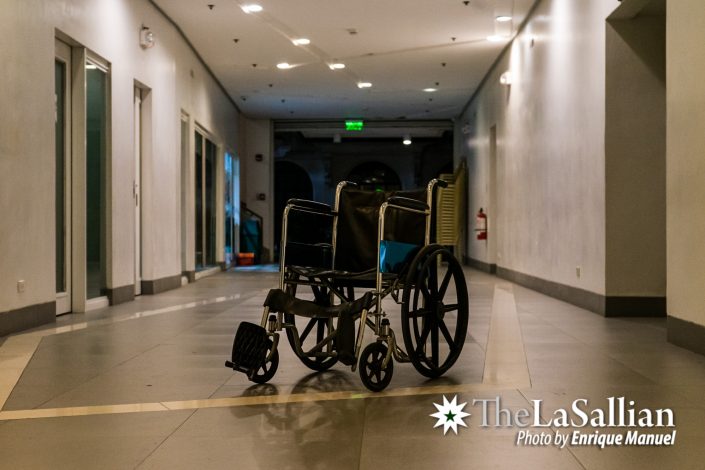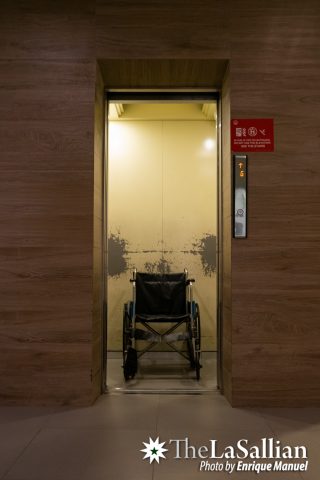While DLSU is far from being the oldest college in the Philippines, many of its facilities herald from decades past. Some of DLSU’s oldest buildings include St. La Salle Hall, which was completed in 1924, and St. Joseph (SJ) Hall and St. Miguel Hall, which were built in 1956 and 1969, respectively. Despite their early origins, these facilities still remain as cornerstones of DLSU.
But for students and faculty who live with mobility impairment, it quickly becomes obvious that the architecture of these buildings also come from an era that did not give much accommodation to Persons with Disability (PWD).

Pushing through
The original designers of DLSU’s buildings are perhaps not fully to blame. The first national law mandating the inclusion of mobility features in building design was Batas Pambansa Blg. 344, which was enacted in 1983. Existing facilities of establishments and institutions were mandated—“if feasible”—to add ramps, sidewalks, railings, and other structures to “enable the disabled persons to have access” to their facilities, while barring permits for new buildings if they do not comply.
Implementation, however, has lagged immensely. In 2017, Sen. Leila de Lima filed Senate Resolution 534, calling for a review of the law’s implementation after finding a lack of structural features for accessibility—like ramps and railings—even in state institutions.
DLSU’s facilities did, at times, undergo improvement and renovation to facilitate mobility. In St. La Salle Hall, two elevators located on opposite sides of the building were installed, though students usually are not granted access to use the facility. SJ Hall, St. Miguel Hall, and Gokongwei Hall, meanwhile, are all interconnected through warp zones—bridges between certain floors that allow students to transfer buildings without having to traverse entire flights of stairs and pass through gates.
Yet students with mobility impairment express that these conveniences are not enough as problems with elevator traffic and limited intervals between classes still persist.
Lance Orsos (II, ECE2), who has to use crutches after sustaining injuries from his Physical Fitness and Wellness in Individual Sports class, feels like he has to “force” himself to move from one building to another. As most of his classes are at Velasco Hall, he points out, “The travel time from South Gate to Velasco [Hall] before [my injury] was merely less than 10 minutes. Now, it became 30 minutes.”
This, he stresses, does not include the “multiple stops” he makes due to the “tiring” use of crutches. Because of this, Orsos makes it a rule to start moving 30 minutes before his class starts. He says that this can “prevent any unforeseen circumstances” that would cause him further delays getting to class.
Attempting to address these concerns, Associate Vice Chancellor for Facilities Management Antonio Maralit assures students who have mobility impairment that the DLSU Security Office provides wheelchairs to help individuals move around campus, as assisted also by a designated security officer.
“I just had to text or call the head [of] security on whether or not I was prepared to be brought from one place to another,” Orsos explains, adding that he would alternate between using a wheelchair and his crutches.
However, the wheelchair proves to be of no help upon reaching St. Miguel Hall, as his class is on the fourth floor. Taking the closest elevator in William Hall then crossing the warp zones along SJ Hall, Orsos can reach as far as the landing space between St. Miguel Hall’s second and third floors, but is left with no other option but to walk up the remaining flights of stairs himself.
He laments, “I had no choice but to try my best to get up [off the wheelchair].” However, Orsos mentions that the designated security officer is there to support him in case he stumbles.

Adjustments made
Among the buildings that have no elevators are SJ Hall, St. Miguel Hall, Gokongwei Hall, and the Faculty Center. Albeit, SJ Hall does provide multiple warp zone accessibilities—two on its third floor, connected to William Hall and St. Miguel Hall on either end; and one on its sixth floor, also connected to William Hall. The Faculty Center and Gokongwei Hall are a different case though, with both buildings housing no nearby accessible elevators.
Sergie Ayson (I, CPE)—who lives with hemophilia, a condition that causes his joints to bleed internally—finds the lack of elevators “troublesome”, especially since climbing up staircases is exhausting for him. He usually takes short breaks while going up buildings, before pushing through with the aid of his crutches. Ayson shares, “I have to go through each step, and, of course, there’s dealing with slight pain [in] every move I make.”
Given his condition, Ayson says that absences and tardiness have become inevitable. To compensate, he would ask his friends to inform his professors on his absence. He would later inform his teacher, citing his reason, and ask for other options to catch up on lessons that he had missed.
Expressing frustration, Ayson says, “Sometimes [my condition limits] what I can and cannot do.” Nevertheless, he is resolute in living a normal student life, further pushing that it would be good if the campus were to acknowledge the struggles of students with mobility impairment.
Plans ahead
The importance of PWD accessibility within campus is not lost to the administration, Maralit explains, citing that many of the renovated areas in the University intend to incorporate such features.
He clarifies, however, that “further study” and the “mobilization of additional resources” are required before plans can be set in motion. Additionally, he mentions, “Some renovations have already been done, but many are still in the pipeline as part of scheduled building renovations and upgrading.”
Maralit admits that until those plans could be completed, the only available option would be to plan in advance the possible routes going to class. That means that students like Orsos and Ayson would still have to endure obstacles as PWDs in the University. Yet the promise of more accessibility features on campus may alleviate some of their problems.
“I hope that some of these buildings will become more PWD-accessible in the future, not just for me, but for [other generations] as well,” Ayson says.
